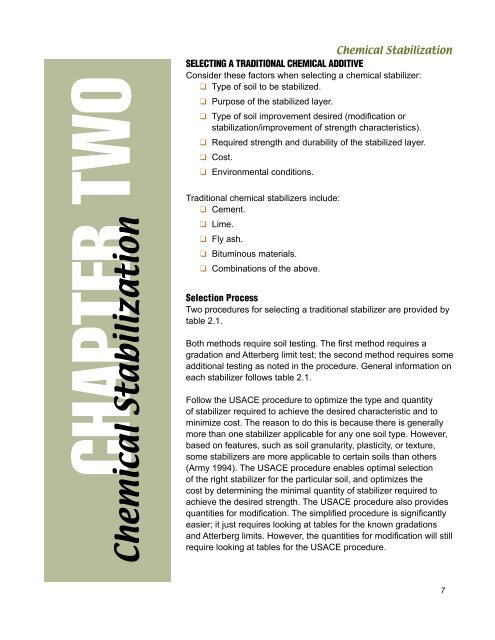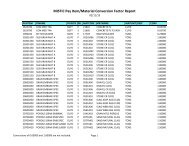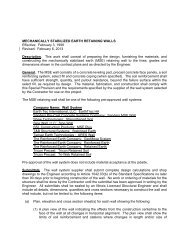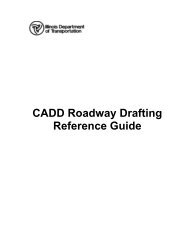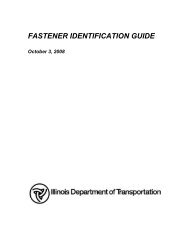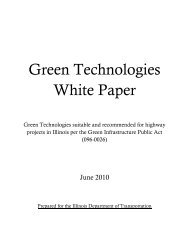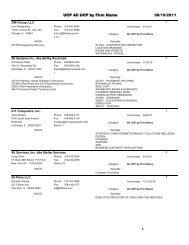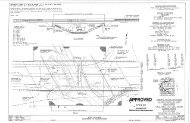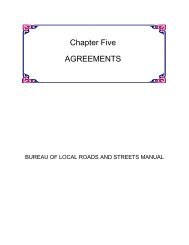Stabilization Selection Guide for Aggregate - Illinois Department of ...
Stabilization Selection Guide for Aggregate - Illinois Department of ...
Stabilization Selection Guide for Aggregate - Illinois Department of ...
You also want an ePaper? Increase the reach of your titles
YUMPU automatically turns print PDFs into web optimized ePapers that Google loves.
CHAPTER TWO<br />
Chemical <strong>Stabilization</strong><br />
Chemical <strong>Stabilization</strong><br />
SELECTING A TRAdITIONAL CHEMICAL AddITIVE<br />
Consider these factors when selecting a chemical stabilizer:<br />
q Type <strong>of</strong> soil to be stabilized.<br />
q Purpose <strong>of</strong> the stabilized layer.<br />
q Type <strong>of</strong> soil improvement desired (modification or<br />
stabilization/improvement <strong>of</strong> strength characteristics).<br />
q Required strength and durability <strong>of</strong> the stabilized layer.<br />
q Cost.<br />
q Environmental conditions.<br />
Traditional chemical stabilizers include:<br />
q Cement.<br />
q Lime.<br />
q Fly ash.<br />
q Bituminous materials.<br />
q Combinations <strong>of</strong> the above.<br />
<strong>Selection</strong> Process<br />
Two procedures <strong>for</strong> selecting a traditional stabilizer are provided by<br />
table 2.1.<br />
Both methods require soil testing. The first method requires a<br />
gradation and Atterberg limit test; the second method requires some<br />
additional testing as noted in the procedure. General in<strong>for</strong>mation on<br />
each stabilizer follows table 2.1.<br />
Follow the USACE procedure to optimize the type and quantity<br />
<strong>of</strong> stabilizer required to achieve the desired characteristic and to<br />
minimize cost. The reason to do this is because there is generally<br />
more than one stabilizer applicable <strong>for</strong> any one soil type. However,<br />
based on features, such as soil granularity, plasticity, or texture,<br />
some stabilizers are more applicable to certain soils than others<br />
(Army 1994). The USACE procedure enables optimal selection<br />
<strong>of</strong> the right stabilizer <strong>for</strong> the particular soil, and optimizes the<br />
cost by determining the minimal quantity <strong>of</strong> stabilizer required to<br />
achieve the desired strength. The USACE procedure also provides<br />
quantities <strong>for</strong> modification. The simplified procedure is significantly<br />
easier; it just requires looking at tables <strong>for</strong> the known gradations<br />
and Atterberg limits. However, the quantities <strong>for</strong> modification will still<br />
require looking at tables <strong>for</strong> the USACE procedure.<br />
7


